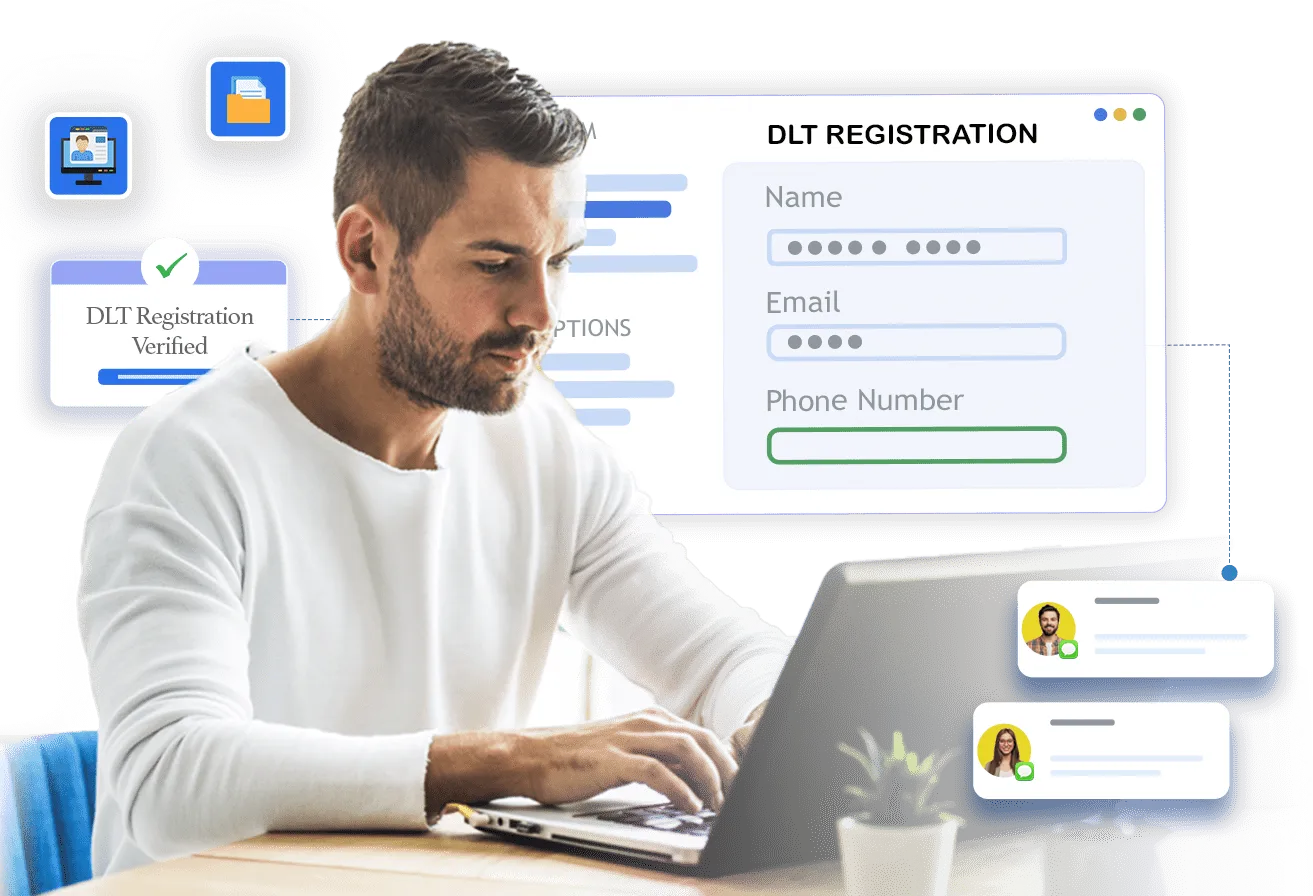Want to
Boost
Your Bussiness??
Start your digital
journey with us—reach out now.
Start your digital
journey with us—reach out now.
A Complete Step-by-Step Guide for Compliance & Template Registration
DLT (Distributed Ledger Technology) is a blockchain-based system introduced by TRAI to control SMS spam and ensure transparency. It enables secure, consent-based communication and is mandatory for sending promotional messages.
Unlike traditional databases, DLT has no centralized storage — every record carries a cryptographic signature and timestamp, helping to prevent fraud.

As per TRAI guidelines, every business or individual intending to send SMS for promotions or services must register on DLT platforms. It helps eliminate Unsolicited Commercial Communication (UCC) and protects customer privacy.

Follow these updated TRAI 2025 guidelines to avoid template rejections and ensure 100% SMS delivery.
DLT (Distributed Ledger Technology) is a blockchain-based registration system mandated by TRAI. It creates a secure and transparent record of all entities, telemarketers, sender IDs (headers), and message templates used for commercial communications in India. This decentralized ledger helps prevent fraud and ensures that all SMS/voice communication adheres to regulatory guidelines.
TRAI has made DLT registration mandatory for all businesses and individuals (Principal Entities) that intend to send commercial SMS or make voice calls. This is a crucial step to:
Every entity (individual, company, government agency) that wants to send SMS messages (transactional, promotional, or service-related) to their customers in India must register as a Principal Entity on a DLT platform. Telemarketers (SMS service providers like Smart 5 Solutions) also need to register themselves.
Yes, most DLT platforms charge a one-time registration fee for Principal Entities, which is typically around INR 5900 (including GST). Smart 5 Solutions can guide you on the specific charges and recommended platforms.
Generally, you will need the following documents:
The DLT registration process typically involves three main phases after selecting a DLT operator (e.g., Jio, Airtel, Vodafone-Idea, BSNL):
There are multiple DLT platforms operated by different telecom providers (Jio, Airtel, Vodafone-Idea, BSNL, etc.). You only need to register on one DLT platform as a Principal Entity, and your registration will be synced across others. Smart 5 Solutions can recommend a platform that is generally faster or more convenient for our clients.
The approval process for Entity Registration usually takes 2-7 business days, depending on the operator and accuracy of submitted documents. Header and Template approvals typically take 1-3 working days each after your Entity is approved.
As per TRAI regulations, if you are not DLT registered, your commercial SMS messages will be blocked by telecom operators. Only messages from DLT-approved Headers and using DLT-approved Content Templates will be delivered.
Smart 5 Solutions provides comprehensive assistance for DLT registration:
Yes, after successful DLT registration and approval of your Entity, Headers, and Content Templates, you will need to:
DLT categorizes SMS traffic to ensure proper compliance and filtering:
Variables (e.g., `{#var#}`) are placeholders in your DLT content templates that allow you to insert dynamic content (like customer names, OTPs, or order numbers) without needing to register a new template for every unique message. For example, a template might be: "Dear {#var#}, your OTP is {#var#}. This OTP is valid for 10 minutes. - Smart 5." The number of variables and their positions must be fixed during template registration. Smart 5 Solutions' platform will allow you to replace these variables with actual data when sending messages.
It depends on the SMS category:
Attempting to send messages to DND numbers without proper categorization or consent will result in delivery failure and potential penalties.
SMS scrubbing is the process where telecom operators, powered by the DLT system, automatically check every SMS before delivery. During scrubbing, the system verifies:
If any of these checks fail, the SMS is blocked, resulting in a DLT error code.
Yes, some aspects of DLT registration may have validity periods.
It's crucial to stay updated with the specific DLT platform's guidelines for renewal processes.
No, approved DLT content templates cannot be modified directly. If you need to make any changes to an existing template – even minor text adjustments or variable changes – you must submit it as a new content template for fresh approval. This ensures that all message content used is strictly vetted by the DLT system.
You can check the status directly on the DLT platform where you registered. Each DLT operator's portal (e.g., Jio, Airtel, Vodafone-Idea, BSNL) has a section dedicated to tracking the status of your Entity registration, Header approvals, and Content Template approvals. You will typically find sections like "My Entity Status," "My Headers," and "My Templates" after logging in. Smart 5 Solutions can guide you on navigating these portals if you face difficulties.